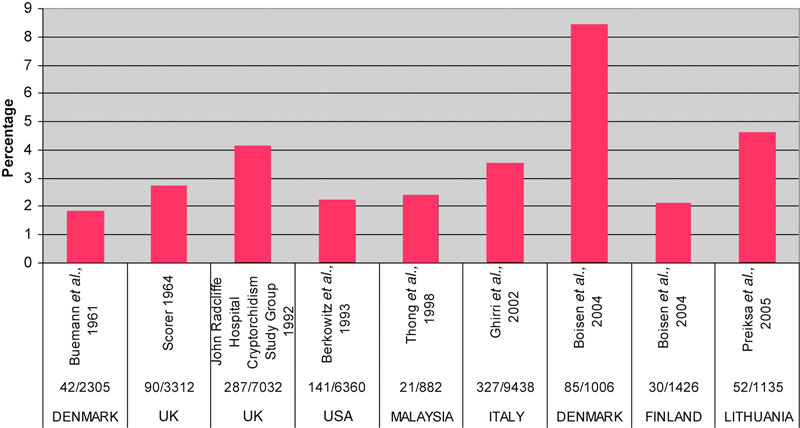File:Newborn- cryptorchidism normal birthweight.jpg
Newborn-_cryptorchidism_normal_birthweight.jpg (800 × 428 pixels, file size: 47 KB, MIME type: image/jpeg)
Newborn- cryptorchidism normal birthweight
Percentage of newborn boys with birth weight ≥ 2500 g having cryptorchidism in cohort studies. Number of cases per number of boys examined is also shown
- "Prospective clinical studies have shown that the prevalence of cryptorchidism among boys with birth weight > or =2500 g has increased in UK from 2.7 to 4.1% between the 1950s and the 1980s and in Denmark from 1.8 to 8.4% between the 1950s and the 1990s. In similar studies performed in different countries during the last two decades the figures have varied from 2.1 to 8.4%. Due to spontaneous descent of the testes lower figures, i.e. between 0.9 and 1.8% have been described at 3 months. Acquired cryptorchidism contributes to the increase in the rate of cryptorchidism in school-aged children. Testicular descent occurs in two phases. During the first phase, before midgestation, testis remains anchored to the inguinal area by insulin like hormone 3 (INSL3)-driven development of the gubernaculum. The second inguinoscrotal phase is dependent on testicular androgens and it is usually completed by the time of birth. Mutations of specific genes have rarely been reported in cryptorchidism. However, several risk factors for cryptorchidism, such as preterm birth and low birth weight, have been described. Environmental factors may also have a role in the etiology of cryptorchidism. Future studies on the gene-environment interaction will give new insights to the pathogenesis of cryptorchidism."
Original file name: Figure 1 http://humupd.oxfordjournals.org/content/14/1/49/F1.expansion.html
Reference
Virtanen HE & Toppari J. (2008). Epidemiology and pathogenesis of cryptorchidism. Hum. Reprod. Update , 14, 49-58. PMID: 18032558 DOI.
Copyright
© The Author 2007. Published by Oxford University Press on behalf of the European Society of Human Reproduction and Embryology. All rights reserved. For Permissions, please email: journals.permissions@oxfordjournals.org
The online version of this article has been published under an open access model. Users are entitled to use, reproduce, disseminate, or display the open access version of this article for non-commercial purposes provided that: the original authorship is properly and fully attributed; the Journal and Oxford University Press are attributed as the original place of publication with the correct citation details given; if an article is subsequently reproduced or disseminated not in its entirety but only in part or as a derivative work this must be clearly indicated. For commercial re-use, please contact journals.permissions@oxfordjournals.org
Cite this page: Hill, M.A. (2024, April 19) Embryology Newborn- cryptorchidism normal birthweight.jpg. Retrieved from https://embryology.med.unsw.edu.au/embryology/index.php/File:Newborn-_cryptorchidism_normal_birthweight.jpg
- © Dr Mark Hill 2024, UNSW Embryology ISBN: 978 0 7334 2609 4 - UNSW CRICOS Provider Code No. 00098G
File history
Click on a date/time to view the file as it appeared at that time.
| Date/Time | Thumbnail | Dimensions | User | Comment | |
|---|---|---|---|---|---|
| current | 13:30, 24 October 2010 |  | 800 × 428 (47 KB) | S8600021 (talk | contribs) | ==Newborn- cryptorchidism normal birthweight== Percentage of newborn boys with birth weight <nowiki> ≥ 2500 g</nowiki> having cryptorchidism in cohort studies. Number of cases per number of boys examined is also shown :"Prospective clinical studies h |
You cannot overwrite this file.
File usage
The following 2 pages use this file:
